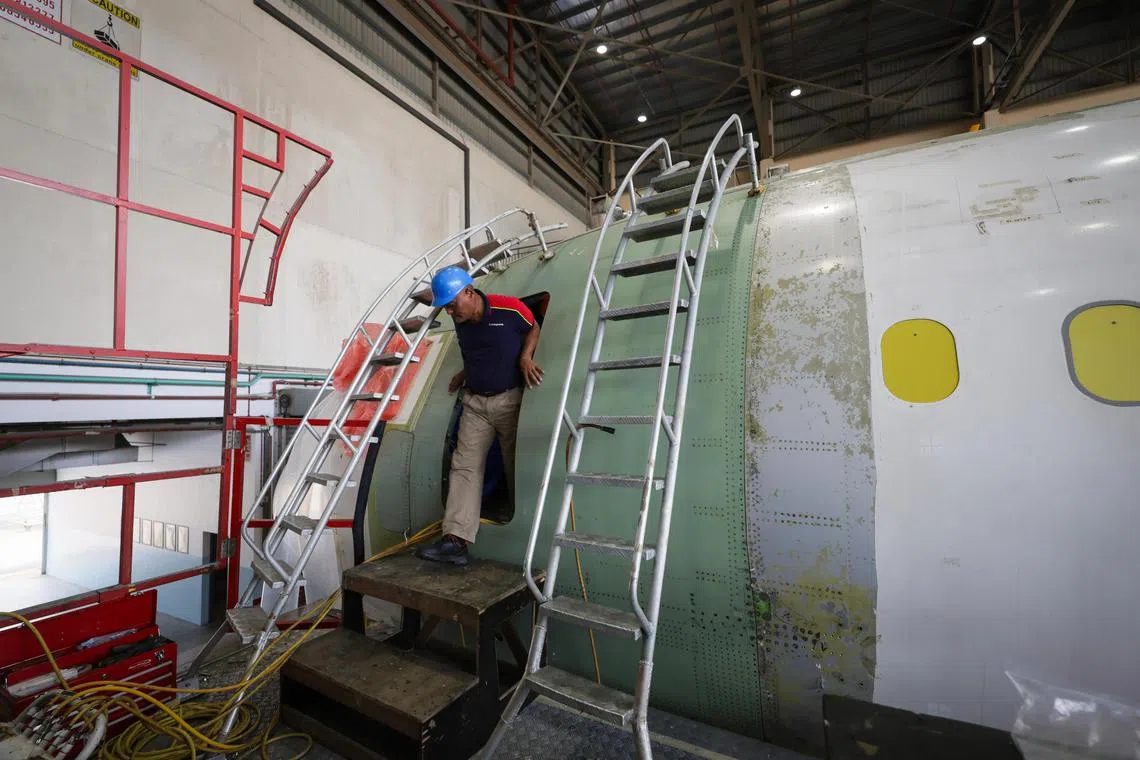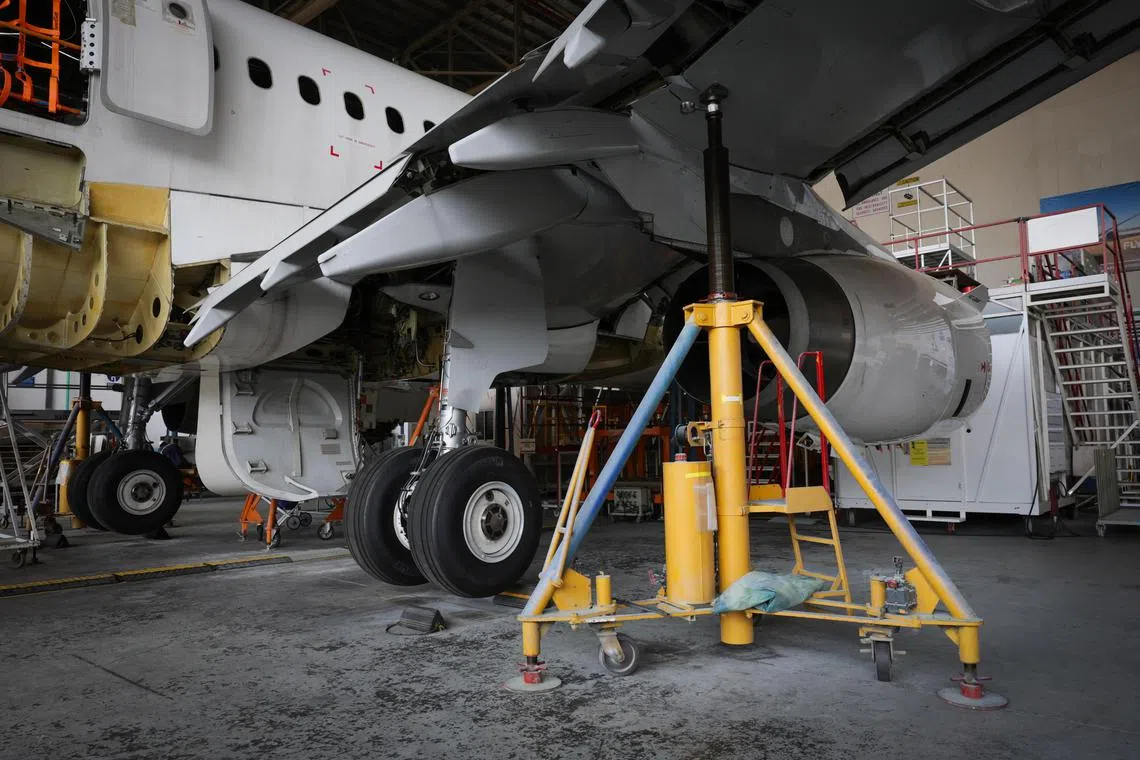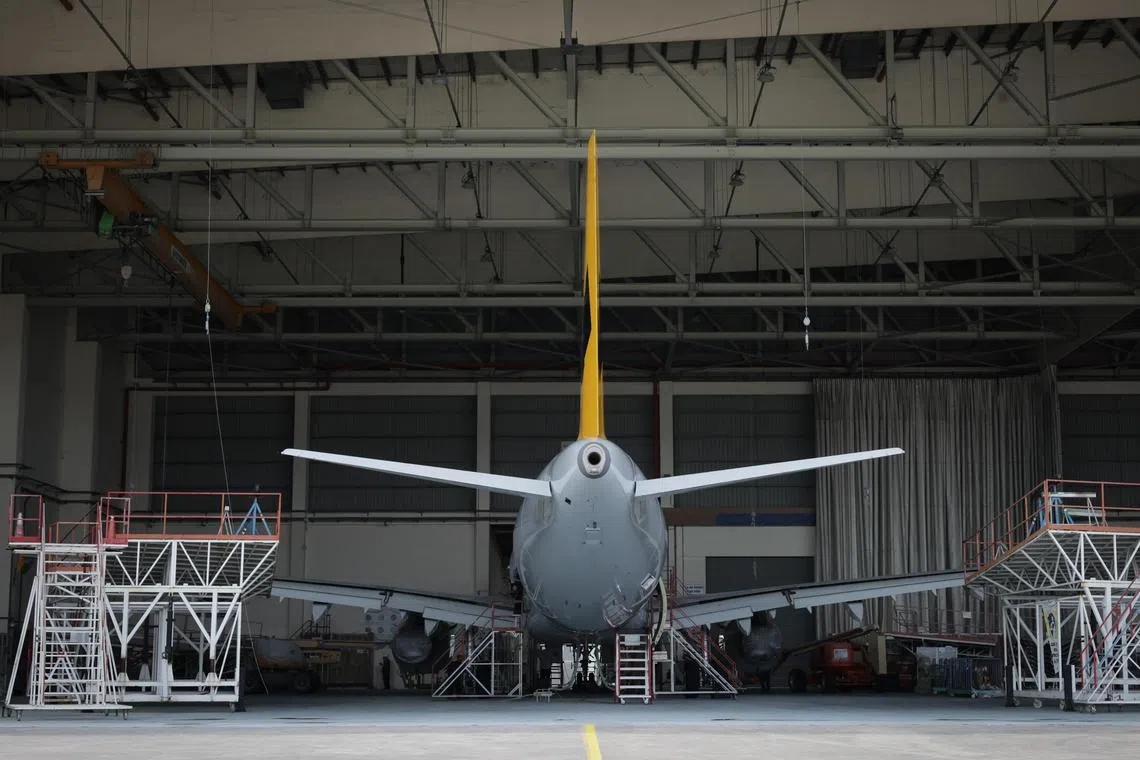Older airliners converted to freight aircraft by ST Engineering in Seletar
Sign up now: Get ST's newsletters delivered to your inbox

ST Engineering project manager M. Razali Ahmad, 62, exits the crew door of an Airbus A321 being converted into a freight carrier at Seletar Aerospace Park.
ST PHOTO: GIN TAY
Follow topic:
SINGAPORE - Not many people know that the freight aircraft carrying cargo around the world – including the online shopping haul of Singaporeans – have a connection to the city state.
Singapore technology and engineering firm ST Engineering has established itself as a key player in the passenger-to-freighter (P2F) conversion segment of the global aviation industry, which gives older passenger planes a second lease of life by modifying them to carry cargo instead.
These conversion capabilities are being exhibited at the Singapore Airshow, which runs until Feb 25.
Since ST Engineering started carrying out conversions with Boeing and McDonnell Douglas aircraft in the 1990s, it has become one of the world’s largest businesses in this area. Previous clients for its P2F conversions include global logistics giant FedEx and the Royal New Zealand Air Force.
The company has since developed a process to convert Airbus A320, A321 and A330 airliners into freighters using data from the European aircraft manufacturer through Elbe Flugzeugwerke (EFW), a joint venture between ST Engineering and Airbus. The A320, A321 and A330 are among the more commonly used commercial passenger aircraft.
ST Engineering’s facility at Seletar Aerospace Park is one of several locations around the world where Airbus A320s and A321s are converted. The work is carried out in two large hangars, which together can convert up to 10 to 12 aircraft in a year.
The facility, which employs 370 people in its airframe services business, delivered the world’s first converted A321 and A320 in October 2020 and July 2022, respectively. Since then, it has delivered more than 20 such planes.
In addition, EFW’s facilities in Dresden, Germany; Guangzhou and Shanghai, China; and San Antonio, the United States, have also converted close to 70 aircraft to date.
The A330s are converted primarily in Dresden, with the facilities in Shanghai and San Antonio also involved. ST Engineering has also signed agreements with other third-party conversion facilities in Turkey and China.
Each conversion takes approximately three months and involves several aspects, Mr Lee Wai Mun, deputy general manager of airframe services at ST Engineering Aerospace, told The Sunday Times during a visit to the P2F conversion facility in Seletar.
This includes the removal of all the equipment from the aircraft’s former life as a passenger plane, including seats, entertainment systems and associated wiring, along with the existing cabin floor, interior cladding and insulation.
A large section of the aircraft’s front fuselage is then cut out to facilitate the installation of a large, upward-opening side cargo door, and a new, strengthened floor in the main cabin to carry cargo pallets.
The removal of a section of the forward fuselage requires the aircraft to be jacked up with its wheels off the ground and placed on a specially designed cradle.
This is to ensure the fuselage remains free of stresses and prevents it from bending or twisting, which would compromise its structural integrity. The fuselage is inspected throughout the conversion process to ensure that this does not occur.

One of four jacks used to prop up the aircraft undergoing conversion.
ST PHOTO: GIN TAY
Most of the aircraft’s existing passenger doors are also removed and replaced by door plugs. The front passenger door is replaced by a smaller door for the pilots, which is moved forward to free up space for more cargo.
The converted A320 can carry 21 tonnes of cargo, while the longer A321 can carry 28 tonnes. In comparison, an intercontinental wide-body Boeing 747 freighter can carry 128 tonnes of cargo.
Cargo is often carried in containers known in the aviation industry as Unit Load Devices, which simplify the loading onto aircraft as well as enable efficient planning of aircraft weight and balance.
ST Engineering’s facility in Seletar is also capable of carrying out scheduled maintenance of A320 and A321 aircraft for aircraft operators.

ST Engineering staff install an interior skin in the main cabin of an Airbus A321 airliner, as part of the conversion process.
ST PHOTO: GIN TAY
During ST’s visit, at least one aircraft that was converted into a freighter in Seletar was back for what is known as a C-check, a heavy maintenance check typically carried out every 18 to 24 months, when the aircraft’s structural components and electrical systems are thoroughly inspected.
The company has also gone into the aircraft leasing business, with its aviation asset management arm, Juniper Aviation Investments, leasing aircraft it has converted into freighters to operators such as Malaysia’s Raya Airways.
ST Engineering said it continues to see strong demand for P2F conversions in the coming years as the e-commerce market remains strong globally after its huge growth during the Covid-19 pandemic.
The need for quick turnaround and delivery means that a lot of the cargo has to be shipped by air, leading to strong demand for freighter aircraft in recent years.
P2F conversions are also a cost-effective way for cargo airlines to acquire aircraft, compared with buying brand new freighters off the production line, said the company. ST understands that second-hand aircraft prices vary markedly, according to how old and how used they are.

The rear of an Airbus A321 airliner being converted into a freight aircraft at Seletar Aerospace Park.
ST PHOTO: GIN TAY


